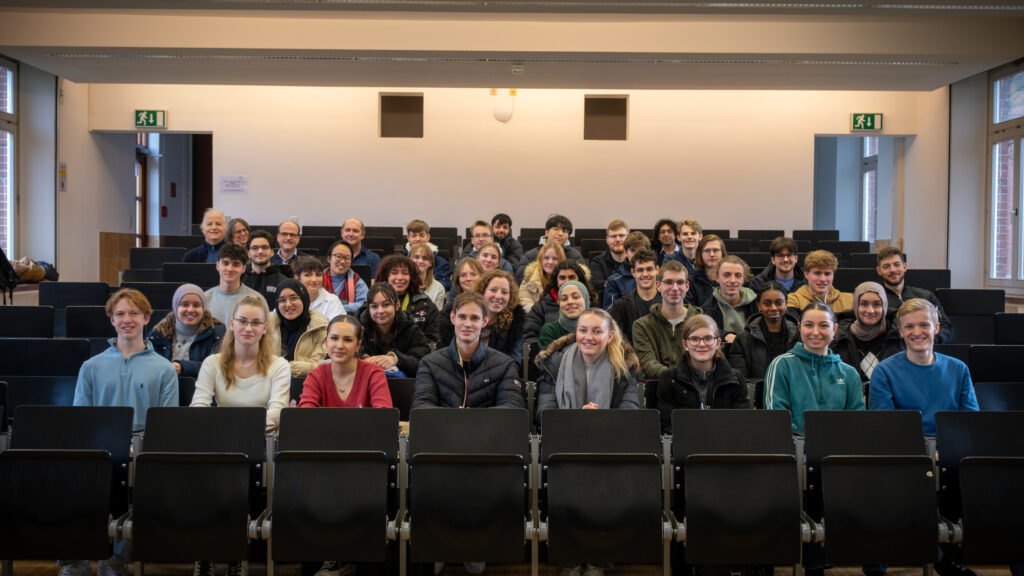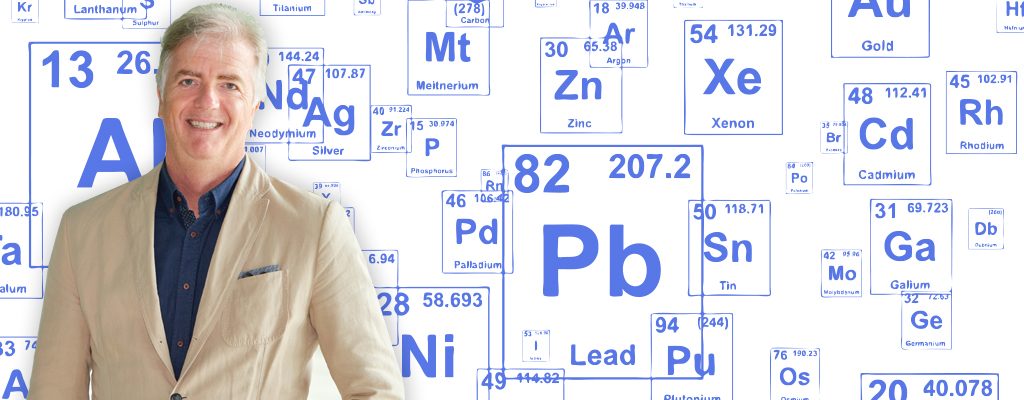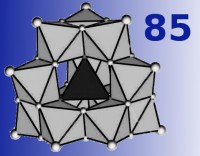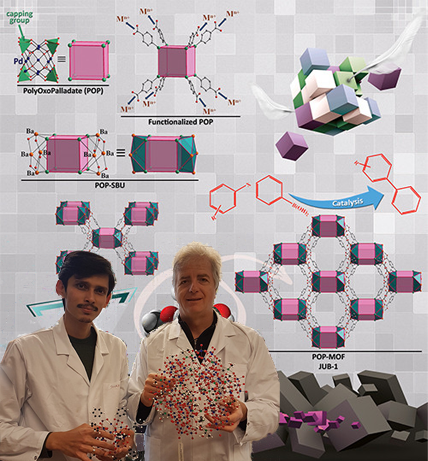
News
Special Issue: Forum on Polyoxometalate and Metal-Oxo Chemistry

This Special Issue features outstanding contributions that reflect the growing breadth and impact of polyoxometalate (POM) chemistry across disciplines. From structural design to functional applications, the articles in this Special Issue showcase innovative developments in the synthesis, reactivity, and utility of POM-based systems. The global authorship reflects the international momentum driving the field. Together, these studies offer a rich and timely snapshot of where POM research stands today – and where it is headed next.
This Special Issue is led by an Editorial written by Guest Editors Prof. Ulrich Kortz and Prof. Craig L. Hill.
👏 👏 👏 Bravo!

Let’s give a big Constructor congratulations to Matteo Lüderitz, a second-year #Chemistry and #Biotechnology (CBT) major at Constructor University, who was recently selected for the prestigious August Wilhelm von Hofmann fellowship from the German Chemical Society (GDCh).
MIT and Constructor University inspire the next generation of STEM leaders at MINTernational 2025

From January 20 through January 24, Constructor University once again welcomed students from the world-renown Massachusetts Institute of Technology (MIT) for another week of MINTernational workshops. In its eighth year, the joint program, sponsored this year by JetBrains and the Schütting Stiftung foundation, gave 40 Bremen-area high school students a chance to go deep on STEM subjects in workshops created and led by students from MIT and CU.
Homecoming for former CU alumnus Dr. Ali Haider, PhD graduate, class of 2015

After getting his PhD at Constructor University back in 2015, Dr. Ali Haider embarked on a career at Quaid-i-Azam, the top university in Pakistan—Dr. Haider’s home country. Dr. Haider recently had a homecoming of sorts as he returned to the campus of Constructor University. We spoke to Dr. Haider about his time here in Bremen and his current university back home in this installment of our Faces of Constructor series.
Another MINTernational Success for Constructor University and MIT
Constructor University and the Massachusetts Institute of Technology (MIT) celebrated another year of MINTernational workshops on campus at Constructor University from January 22nd-26th. The joint program offered high school students from Bremen and the local region the opportunity to ignite their passion for STEM subjects.

Alumnus Sib Sankar Mal returns to Constructor University as Humboldt Fellow

In 2008 he celebrated his doctoral degree at the private university in Bremen, today he is a professor at the National Institute of Technology Karnataka in India: Sib Sankar Mal. This June and July, he will be back at Constructor University as part of his Humboldt Fellowship membership, conducting research together with his former PhD supervisor, Professor Ulrich Kortz.
Link To: Jacobs University Bremen News
Hazim Saleem: passion, excellence and a love for chemistry

Yemen, Pakistan, Germany – Hazim Saleem, a student at Constructor University in Bremen, had to adjust to new living conditions many times. However, there is one thing that remains constant: his love for chemistry. Now, Hazim has received the prestigious scholarship of the August Wilhelm von Hofmann Foundation of the German Chemical Society. He was also accepted for the Summer Undergraduate Research Program at New York University within the same week.
Link To: Jacobs University Bremen News
DFG funding success for state-of-the-art chemistry device
Seventeen years after first purchasing a single-crystal x-ray diffractometer, Constructor University in Bremen has recently upgraded to the latest technology. Chemistry Professor Dr. Ulrich Kortz successfully secured funding from the German Research Foundation (DFG) for the second time.
Link To: Jacobs University Bremen News
DFG Funding Success for Franco-German Research in Chemistry

Together with two French colleagues, Professor Ulrich Kortz and Professor Werner Nau from Jacobs University Bremen form the CHAOPOM Consortium. Their bi-national research project “Chaotropic Polyoxometalates: From Fundamentals to Applications” is now being funded by the German Research Foundation (DFG) and its French counterpart, the Agence Nationale de la Recherche (ANR), with almost one million euros for the next three years.
Link To: Jacobs University Bremen News
Congratulations to Anusree, Xiang and Ananthu for having climbed the PhD mountain!!!

CHEMISTS AT JACOBS UNIVERSITY DISCOVER NEW CLASS OF COMPOUNDS

May 31, 2022
Scientists at Jacobs University Bremen led by Ulrich Kortz, Professor of Chemistry, have achieved a breakthrough in the field of precious metal-oxo chemistry. For the first time, researchers have synthesized cationic, meaning positively charged, metal-oxo clusters based on palladium. They report on the synthesis and properties of these compounds in the renowned journal Angewandte Chemie, which classifies the article as a Hot Paper and thus as a particularly important contribution. The research project involved the working groups of four professors at Jacobs University.
Link To: Jacobs University Bremen News
RESEARCH PROJECT ON HOST-GUEST CHEMISTRY AT JACOBS UNIVERSITY

They are as circular as a wheel and enclose a space with a diameter of about two nanometers. Researchers at Jacobs University Bremen led by Professor of Chemistry Ulrich Kortz want to use such a cavity of a molecule based on molybdenum and oxygen to be able to transport medically active substances into the body in a targeted manner. The three-year basic research project is funded by the German Research Foundation (DFG) with approximately 230,000 euros.
Link To: Jacobs University Bremen News
A PASSION FOR CHEMISTRY: THE LONG ROAD OF TWO DAAD SCHOLARSHIP HOLDERS TO THEIR DOCTORATES

As a Christian, Sahar Khandan was not allowed to do her doctorate in Iran. Mahmoud El Cheikh Mahmoud grew up as a stateless Palestinian in Lebanon. Both are outstanding young scientists, both share a passion for chemistry. And both have now received a doctoral scholarship from the German Academic Exchange Service (DAAD) that will enable them to conduct their research at Jacobs University Bremen. “This is a wonderful achievement, they both deserve it for their passion and perseverance,” said chemistry professor Ulrich Kortz, to whose research group they both belong.
Link To: Jacobs University Bremen News
SCIENTISTS AT JACOBS UNIVERSITY BREMEN RESEARCH A NEW CLASS OF MATERIALS CONTAINING PRECIOUS METALS

Precious metals such as platinum, palladium, gold, rhodium or iridium can be found in a variety of everyday products, for example in catalytic converters of cars, in mobile phones and laptops as well as in solar cells. They are particularly interesting for chemists because of their low reactivity with other elements. A team of researchers, led by Professor Ulrich Kortz at Jacobs University Bremen, now wants to develop a new class of materials containing precious metals and investigate their possible applications. “These materials will be very exciting not only for catalysis, but also for quantum computers and data storage,” says Prof. Kortz. The project is funded by the German Research Foundation with around 200,000 euros.
Link To: Jacobs University Bremen News
Nickolet Ncube: From Bulawayo to Bremen
A doctoral student finds her path in chemistry at a private university in northern Germany. Outside the lab, she’s fighting for better education for young girls on both continents
Link to ZEIT Campus: FROM BULAWAYO TO BREMEN
Honorary Doctorate for Prof. Ada Yonath (Nobel Prize 2009 Chemistry)
Ada E. Yonath
Congratulations, Jan!!!
Link to Jacobs press release: Recycling Of Rare Earth Elements; Student Of Jacobs University Bremen Made It To The Finals Of ‘Jugend Forscht’, The German Youth Science Competition
Jan Felix Schuster, student at Jacobs University, made it to the finals of ‘Jugend forscht’ (Source: Jacobs University)
To make it to the final was his goal. “I’m really happy that it worked out,” says Jan Felix Schuster. The 19-year-old qualified for the national finals of the youth competition ‘Jugend forscht’ in Chemnitz from 16 to 19 May. He is the state champion of Bremen in the field of chemistry, and participating is more important than winning for him. “Getting to know the other projects and making new contacts is what I enjoy most about ‘Jugend forscht‘”.
Congratulations, Lisa!!
Link to Jacobs press release: Lisa Tichagwa: an exceptional chemistry student
Medicine? Yes! Engineering? Yes! But chemistry? Better not. “When people in Zimbabwe say that they want to study chemistry, most people ask: ‘What will you do with it?’ “, tells Lisa Tichagwa. “They normally suggest other subjects.” The 21-year-old nevertheless decided to study chemistry at Jacobs University Bremen. Now she has been awarded the August Wilhelm von Hofmann scholarship of the German Chemical Society (GDCh) for her outstanding academic achievements – and she feels satisfied with her choice. “The scholarship shows me that I made the right decision.”
Discovery of Polyoxo-Noble-Metalate-Based Metal-Organic Frameworks
Link to JACS paper: Discovery of Polyoxo-Noble-Metalate-Based Metal-Organic Frameworks
Link to Jacobs press release: Researchers at Jacobs University Bremen Discover A New Class of Heterogeneous Catalysts Based on Precious Metals
Ulrich Kortz (right), Professor of Chemistry at Jacobs University in Bremen, and his coworker Dr. Saurav Bhattacharya (left) with a POM model. (Source: private)
It is stable and recyclable: a team of scientists from Jacobs University led by Ulrich Kortz, Professor of Chemistry, has developed a new class of materials in close cooperation with researchers from the Carl von Ossietzky University of Oldenburg and the Technical University of Munich. The compound based on the precious metal palladium paves the way for the full use of the entire class of discrete polyoxopalladates (POPs) as building blocks for 3D framework materials (MOFs). The project was funded by the German Research Foundation (DFG). The name of the new class of materials: POP-MOF, JUB-1.
Celebrating Polyoxometalate Chemistry (European Journal of Inorganic Chemistry/ Volume 2019, Issue 3-4)
Michael Pope, Masahiro Sadakane, and Ulrich Kortz present a short history of polyoxometalates, listing important anniversaries.
Read the guest editorial
Special issue of Zeitschrift für Anorganische und Allgemeine Chemie (ZAAC)
The palladium(II)-containing 40-tungsto-4-arsenate(III) [Pd2Na2KAs4W40O140(H2O)]21– was synthesized by reaction of PdSO4 with the cryptate heteropolyanion [As4W40O140]28– in potassium acetate buffer. The title compound was characterized by single-crystal XRD, IR, TGA, and elemental analysis.
Special issue on Polyoxometalates (Acta Crystallographica Section C)
The development of polyoxometalate (POM) chemistry during the last half-century or so has benefitted tremendously from single-crystal X-ray diffraction. Besides structural aspects, the study of the physicochemical properties of POMs has developed tremendously in recent decades. The multitude of attractive properties includes controllable size, composition, charge density, redox potential, acid strength, high thermal stability in the solid state, solubility in polar/nonpolar solvents and reversible electron/proton storage. Such versatility renders POMs of interest for academic and industrial applications, especially in catalysis. The contributions to this special issue on POMs provide an excellent overview of the current state of the subject, as well as providing updates to current reseach.
Guest Editors: José Ramón Galán-Mascarós (Institute of Chemical Research of Catalonia (ICIQ), Spain) and Ulrich Kortz (Jacobs University, Germany)
Congratulations, Qianyu!!
Qianyu Feng has won the Jacobs Dean’s Prize 2018 for the best Bachelor thesis in the focus area Health. She performed BSc research in the laboratory of Prof. U. Kortz and the title of her thesis is “Synthesis and Characterization of (a) Cubic Polyoxopalladate-Based Metal-Organic Framework and (b) Wheel-Shaped 27-Tungsto-3-Arsenate(III), [K(AsW8O30)3(WO(H2O))3]14-”. She is the coauthor of one publication: Selective Rb+ vs K+ Guest Incorporation in Wheel-Shaped 27-Tungsto-3-Arsenate(III) Host, [M⊂{(β-AsIIIW8O30)(WO(H2O))}3]14-(M = K, Rb), Kandasamy, B.; Sudmeier, T.; Ayass, W. W.; Lin, Z.; Feng, Q.; Bassil, B. S.; Kortz, U. Eur. J. Inorg. Chem. 2018. After graduation at Jacobs this summer Qianyu has now left Bremen in order to pursue graduate studies in Chemistry at ETH Zurich, Switzerland.
Polyoxopalladate review in Accounts of Chemical Research now online
- Discovery and Evolution of Polyoxopalladates
Yang, P.; Kortz, U. Acc. Chem. Res. 2018, [Read Online]
CONGRATULATIONS, AMNA!

For her outstanding academic achievements in chemistry, Amna Rubab has been awarded the prestigious Hofmann Scholarship of the German Chemical Society (GDCh).
85th BIRTHDAY CELEBRATION OF THE “KEGGIN STRUCTURE”
 2018 marks the exciting 85th birthday celebration of the “Keggin structure”, which itself is at the center of polyoxometalate (POM) chemistry! The first polyoxoanions were reported almost two centuries ago by Berzelius (1826), but J. F. Keggin could only characterize them structurally in 1933 [1]. He solved the structure of the free acid H3PW12O40 using powder X-ray diffraction, a highly symmetrical metal-oxo anion with tetrahedral symmetry (see Fig. 1). The availability of X-ray diffraction techniques paved the way for the discovery of a large number of novel POMs with different shapes and sizes. Keggin is our POM pioneer!
2018 marks the exciting 85th birthday celebration of the “Keggin structure”, which itself is at the center of polyoxometalate (POM) chemistry! The first polyoxoanions were reported almost two centuries ago by Berzelius (1826), but J. F. Keggin could only characterize them structurally in 1933 [1]. He solved the structure of the free acid H3PW12O40 using powder X-ray diffraction, a highly symmetrical metal-oxo anion with tetrahedral symmetry (see Fig. 1). The availability of X-ray diffraction techniques paved the way for the discovery of a large number of novel POMs with different shapes and sizes. Keggin is our POM pioneer!
DAAD PRIZE-WINNER NICKOLET NCUBE: ACHIEVING SOMETHING ON ONE’S OWN

She can perfectly recall the first days at her secondary school in her hometown of Bulawayo in Zimbabwe. Her physics teacher? A man. The mathematics teacher? A man. The biology teacher? A man. “But then this teacher walked into the classroom and I thought, ‘Wow, a woman who teaches chemistry!’” Nickolet Ncube recollected. “She got me fascinated in the subject, she inspired me, I wanted to be like her one day.”
PHD STUDENT WITH PASSION FOR CHEMISTRY AND OPERA

A scientific paper changed his life. He had not the slightest idea about Jacobs University, knew nothing about Bremen, and little about German culture and of course did not speak any German. However, while in Saudi Arabia, Wassim W. Ayass read a research paper on polyoxometalates by chemistry professor Ulrich Kortz, which propelled him to successfully apply to Jacobs University as a PhD student. Today, Ayass says: “I want to stay in Germany and build the rest of my life here”.
FROM INDIA TO BREMEN AND BACK: TOP TALENT IN FURTHER TRAINING

July 27, 2017
She grew up in a small Indian village and was the first in her family to pursue university studies – Dr. Paulami Manna is now attending Jacobs University for one year. As a holder of a fellowship from the renowned Schlumberger Foundation, she conducts research as a post-doc in chemistry professor Ulrich Kortz’s working group. “The fellowship promotes top female talents from developing countries who return to their home countries after their studies abroad”, explains Prof. Kortz. “This is really great. I am very pleased that Paulami succeeded”.
67TH LINDAU NOBEL LAUREATE MEETING

Inga Dammann (BSc Chemistry, 2017) and Wassim W. Ayass (PhD, Chemistry, 2017)
July 6, 2017
The two Jacobs students Inga Dammann (BSc Chemistry, 2017) and Wassim W. Ayass (PhD Chemistry, 2017) qualified in a competition among young scientists worldwide to participate in the 67th Lindau Nobel Laureate Meeting dedicated to Chemistry from 25 – 30 June 2017.
420 scientists from 78 countries participated and met around 30 Nobel laureates, attended their lectures, and had discussions with them. Inga was funded by the Verband der Chemischen Industrie (VCI) and Wassim was supported by the German Academic Exchange Service (DAAD) and co-funded by the OPEC Fund for International Development (OFID). Both Inga and Wassim are members of the research group of Prof. Ulrich Kortz at Jacobs University, performing research on synthetic inorganic materials chemistry and catalysis.
More info about the Lindau Nobel Laureate Meeting in this video:
http://mediatheque.lindau-nobel.org/videos/36833/opener
Pioneer of Materials Research

“You have to do things others have not yet done; combine chemicals that others have not yet combined; under conditions that have not yet been tried.” Ulrich Kortz sees himself as a passionate basic researcher. In 2008, the Chemistry Professor at Jacobs University in Bremen discovered a new class of compounds, the polyoxopalladates. Now the scientist and his team have developed another subclass of these functional materials. For the first time, they have combined two precious metals, palladium and silver, in a molecular metal-oxo assembly – with great benefits for science and industry.
Recipe from the nanoworld for cleaner drinking water

Too much manure, too much fertilizer: In many places in Germany, intensive agriculture is endangering water quality. The nitrate levels in groundwater are too high. A research team at Jacobs University led by the Chemistry Professor Ulrich Kortz has now discovered a new way in the lab to reduce nitrate contamination in water – with the help of so-called polyoxometalates, in short: POMs.
ECONOMIC FUEL CELLS WITHOUT PLATINUM: HIGH EFFICIENCY, LOW COSTS

January 26, 2015
Conventional fuel cells based on platinum catalysts are too expensive for widespread use. Cheaper systems, however, are significantly less efficient. An international research group including scientists from Jacobs University has now developed a novel catalyst, without platinum and with higher efficiency.
In the fight against climate change, fuel cells are one beacon of hope. They produce electricity from hydrogen and atmospheric oxygen. Instead of exhaust fumes, the only waste product is water. The required hydrogen can be produced sustainably, for example by solar energy.
Platinum Group Metals in Polyoxometalates

Johnson Matthey and Alfa Aesar support new platinum group metals research
Polyoxometalates (POMs) are a large class of discrete, soluble metal-oxo anions of early transition metals in high oxidation states, such as tungsten(VI) or molybdenum(VI). Due to a unique combination of properties, such as thermal and oxidative stability, tunability of acidity and redox activity, solubility in various media, and ability to undergo multistep multi-electron transfers without structural changes, POMs keep attracting more and more attention in different areas of fundamental and industrial science, in particular in homogeneous and heterogeneous catalysis.
Noble Metal in Action: Jacobs Scientists Create Palladium-Oxide with Extra High Catalytic Potential

February 14, 2011
Ulrich Kortz, Professor of Chemistry at Jacobs University, and his team report the synthesis of a novel, discrete noble metal-oxide, containing a record number of 22 palladium atoms, as well as two central copper ions. In addition to its high catalytic potential, this {Cu2Pd22} cluster compound also exhibits very unusual intramolecular magnetic interactions. The study, which has now been published as a “Very Important Paper” in the Angewandte Chemie International Edition (DOI: 10.1002/anie.201006734), opens new perspectives for a better understanding of noble-metal particulate based oxidation catalysis as well as intramolecular magnetic phenomena of importance in materials and life sciences.
Nützliche Symmetriewunder: Jacobs University veranstaltet Symposion zu Synthese und Anwendungen von Polyoxometallaten
Vom 28. Juli bis 1. August 2009 veranstaltet die Jacobs University ein internationales State-of-the-art-Symposion zu Synthese und Anwendungen von Polyoxometallaten (POM), einer Klasse anorganischer Metall-Sauerstoff-Molekülen mit großer Strukturvielfalt und chemischen Eigenschaften, die für unterschiedlichste Anwendungen interessant sind, darunter Katalyse, Medizin und Materialwissenschaften. Zentrale Themen der Tagung sind Edelmetall-POM, die in Fahrzeugkatalysatoren zur Anwendung kommen, funktionale Hybridmaterialien sowie Theoriebildung. Erwartet werden rund 150 Teilnehmer aus über 20 Ländern. Die Tagung wird von Ulrich Kortz, Professor of Chemistry an der Jacobs University, organisiert.
Jacobs Scientists create new giant molecule
Ulrich Kortz, Professor of Chemistry at Jacobs University, and his team successfully synthesized a polyoxometalate with 100 Tungsten and 20 Cerium atoms that has a molar mass of about 30 kilo Dalton. With a maximum diameter of 4.2 nm the inorganic molecule is comparable in size to large complex bio-molecules or even small viruses. The reaction conditions and the molecular structure are now published as cover story of the current issue of Angewandte Chemie (doi: 10.1002/anie.200701422).
[ Aug 08, 2007] Polyoxometalates are anionic metal-oxygen clusters of large structural diversity with chemical properties, which make them especially interesting for applications in catalysis, but also in materials science and nanotechnology. Ulrich Kortz and his co-workers now achieved the synthethis of the tungstogermanate [Ce20Ge10W100O376(OH)4(H2O)30]56-, which belongs to the polyoxometalates, by condensation of the precursors [α-GeW9O34]10-and Cerium(III) ions in aqueous solution. With about 600 atoms in total, amongst them 100 atoms of the heavy metal Tungsten, the new compound is the third largest molecular polytungstate ever synthesized. In addition it contains the largest number of atoms of the Rare Earth Cerium ever incorporated in such a compound.










